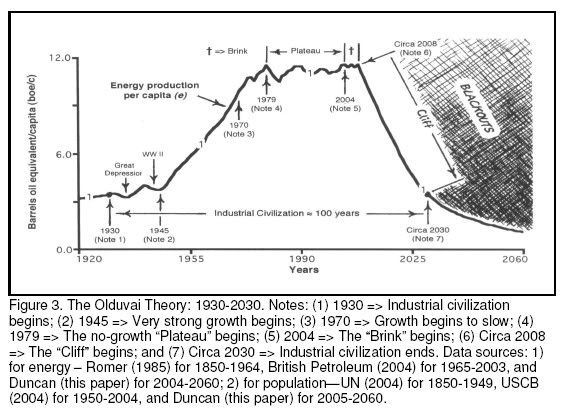The Olduvai Theory
Energy, Population, and
Industrial Civilization
by Richard C. Duncan
http://www.thesocial...wo/xvi-2-93.pdfThe Olduvai Theory states that the life
expectancy of industrial civilization is
approximately 100 years: circa 1930-2030.
Energy production per capita (e) defines it. The
exponential growth of world energy production ended
in 1970 (Postulate 1 is verified). Average e will show
no growth from 1979 through circa 2008 (Postulate 2
is confirmed from 1979 through 2003). The rate of
change of e will go steeply negative circa 2008
(Postulate 3). World population will decline to about
two billion circa 2050 (Postulate 4).
Big Blackouts Are Inevitable
. . . electricity is generated,
transmitted, and distributed by a complex, far-flung,
costly, and fragile infrastructure.
The electric power networks are the largest, most
complex machines ever constructed. They have been
built, rebuilt, and interconnected over many decades
with a baffling variety of hardware, software,
standards, and regulations. The ravenous input nodes
must be continuously fed with immense amounts of
primary energy and then the output nodes deliver
electromagnetic energy to myriad customer loads.
Between the input and output nodes are power
plants, substations, and transmission and distribution
lines and towers.
Inevitably the old equipment wears out or
becomes obsolete so highly educated and skilled
personnel are needed to maintain the grids.
Then there are power control centers that monitor
and manage the generation, transmission, and
distribution of electric power over local, regional, and
super-regional areas. Each control center has
numerous computers, databases, and special software
to monitor and control the flow of power. Thoroughly
trained and dedicated operators are essential to keep
the grids going 24/7/365.
Much faster response times are provided by
“protective relays” that instantly trip for abnormal
conditions, such as short circuits on high-voltage
power lines.
Thus, except for lightning strikes and tornadoes, it
might seem that the power networks would always
operate reliably, thus completely avoiding big
blackouts.
But that is false. Power control specialists J. Apt
and L. B. Lave (2004) have warned:
Data for the last four decades show that
blackouts occur more frequently than theory
predicts, and they suggest that it will become
increasing expensive to prevent these lowprobability,
high-consequence events. The
various proposed “fixes” are expensive and
could even be counterproductive, causing future
failures because of some unanticipated
interaction.
Permanent Blackouts Are Coming
The third catch, according to the Olduvai Theory,
is that sooner or later the power grids will go down and
never come back up. The reasons are many.
The International Energy Agency (lEA, 2004)
estimates that the cumulative worldwide energy
investment funds required from 2003 to 2030 would be
about $15.32 trillion (T, US 2000 $) allocated as
follows:
1. Coal: $0.29T (1.9% of the total),
2. Oil: $2.69T (17.6%),
3. Gas: $2.69T (17.6%),
4. Electricity: $9.66T (63.1%).
Thus the lEA projects that the worldwide
investment funds essential for electricity will be 3.7
times the amount needed for oil alone, and much
greater than all of that required for oil, gas, and coal
combined.
The OT says that the already debt-ridden nations,
cities, and corporations will not be able to raise the
$15.32 trillion in investment funds required by 2030
for world energy. (Not to mention the vastly greater
investment funds required for agriculture, roads,
streets, schools, railroads, water resources, sewer
systems, and so forth.)
Furthermore, because of the rapidly rising cost of
electricity, the increasingly impoverished customers
won*t be able to pay their electric bills. Worse yet, the
really desperate ones will illegally wire directly to the
low-voltage power lines, so without a wattmeter to
record their usage they won*t even have any bills to
pay.
Unfortunately Duncan's accompanying graphs look like they come from one of Jack Chick's evangelizing tracts:















































